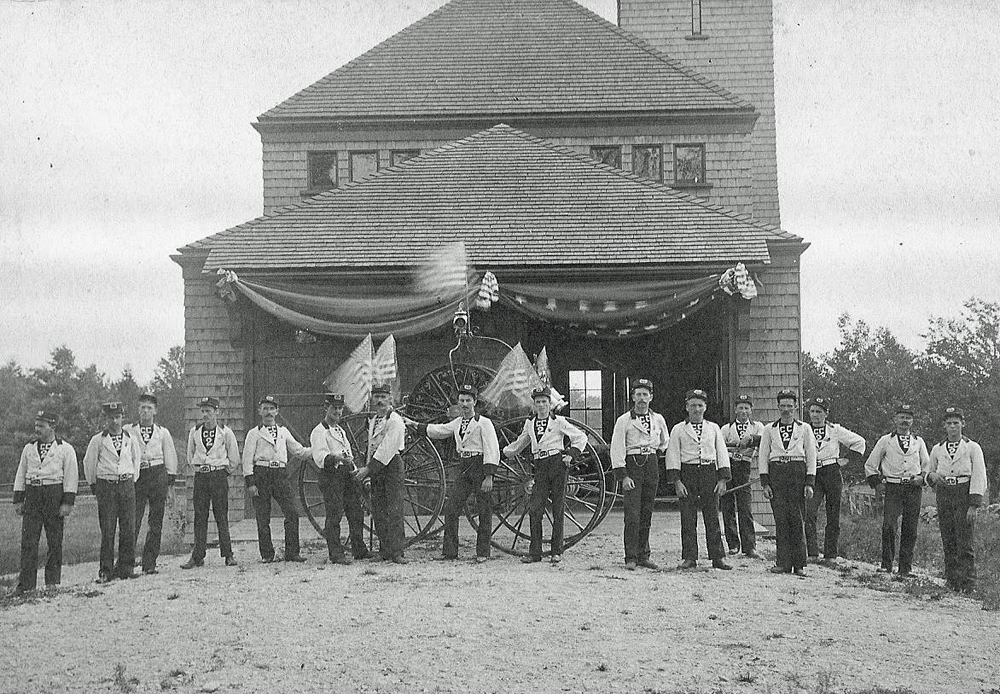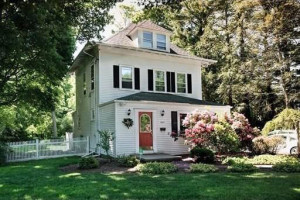True Tales: Canton Corner Firehouse
By George T. Comeau
The members of Hose Company 2 pose outside the firehouse, Sept. 1891. (Courtesy of the Canton Historical Society)
The ad copy reads, “Come see this classic New England home and own a piece of history. Canton’s first firehouse was converted into a single-family home in 1924.” Close, but not quite. This wasn’t Canton’s first firehouse, but it was certainly a big part of our past. The house at 1403 Washington Street is indeed a classic New England home that by all appearances is just a simple shingle-style residence. The backstory, however, is eminently more interesting.
Prior to the American Revolution both church and state were a mixed affair. The early town houses were actually parts of the church. Until 1707, town meetings were held in the meetinghouse that was located adjacent to the Old English Burying Ground in Ponkapoag. As the population shifted south to where present-day Canton Corner is now, the meetinghouses were built in what is now the Canton Corner Cemetery. From 1707 until 1831, municipal government met in what were essentially churches.
In 1824 construction began on the First Parish Church and the old church was torn down and the timbers salvaged for use in the new building. This construction likely necessitated the need for town business to move. The Baptist Society had built a building between 1819 and 1820 on land purchased from Alexander French for approximately $80. A wooden building rose on the site in an impressive fashion. Measuring 40 by 36 feet and two stories and having almost 3,000 square feet of space, it would serve nicely for large gatherings. And, for the time it was built, it was an expensive building. At a cost of $2,000 it had more than 26 windows containing over 625 individual panes of glass. The building formally opened for worship in 1821, and the town began using it for meetings in 1824.
In 1836, the Baptist Society built an even grander modern traditional church building in what is now Canton Center. The old building would be sold, and a committee was appointed to purchase the structure for the use of the community. The town needed a public space and the decision was made to purchase the building for $650. Within a year, the interior space was enlarged by enclosing the upper floor galleries and creating a true second floor. The only other improvement undertaken by the town was to add granite doorsteps in 1842.
The Old Town House, as it became known, was used for almost 50 years. In 1878 town meeting voted to build a new town hall at the corner of Sherman and Washington streets. A memorial to the war dead from the Civil War, Memorial Hall would replace the Old Town House in a spectacular fashion. As more of the community center moved to where it is today, the center for politics shifted with it. In 1884 the Old Town House was sold at auction for $31 and the timbers were removed to the farms at Randolph Street for use in the building of a barn.
There was an old firehouse on the property to the rear of the meetinghouse, and it was decided to build a new one where the town house once stood. In 1890, George Walter Capen, a prominent local architect, was engaged to design a new firehouse. In 1883, Capen had designed the burial vault at Canton Corner Cemetery, as well as several of the Draper family homes on Washington and Chapman streets. Capen was also one of the individuals responsible for designing the town seal that we still use today.
When completed, the building became known as Hose Company Number Two, principally serving the Draper Company complex. The two-story wood frame building had a flared roof. The front of the building had two bays for horse-drawn fire apparatus and most notably a three-story hose tower to the rear of the building. Since the hoses were canvas, each time they were used they would have to be hoisted up to the top of the tower and left to hang down to dry.
The firehouse at Canton Corner served the town for 26 years. It was not the first firehouse in Canton, or the last. It was, however, an important part of keeping the town safe and ensuring that the Draper Mills were well protected. Hose Company Number Two was reputed to be the best in town, but when motorized engines came into use, the need for this station was obviated. A new fire station at Canton Center and the second at Ponkapoag meant that the town would mothball Hose Number Two.
The building was closed in 1916, and the tower was removed sometime later. It seems that several of the youth of the neighborhood would climb the tower and ring the bell, causing some alarm and the scratching of heads. The building remained vacant for several years, until in 1923 at 2 p.m. on an August day the auctioneer’s hammer fell.
Oscar D. Capen, the town sheriff, was also the town auctioneer. Several people showed up to bid on the firehouse. First the heating plant was sold, then the bell from the tower. Finally, the crowd grew hushed as the building itself went on the block. The bids opened at $500 and ended at $3,200 to the winning bidder — Mathew Galligan.
Galligan had been born here (although some sources report his birth as Ireland) in 1869. At an early age he became a butter dealer, then a grocer, eventually buying and selling real estate. He was the Joel Pratt of his day, with literally a hand in just about every transaction of note in early 20th century Canton. Unlike today, this developer valued history and could not be persuaded to tear down the venerable old firehouse. It was a far less disposable period of time — developers and builders saw value in maintaining these well constructed buildings.
Galligan remodeled the firehouse into a residential property, enclosing the engine bays as an entry porch and allowing the engine ramps to become part of the front yard. A simple auto garage was built on the site of the old tower in typical craftsman style. Many of the earlier shingle-style elements remain to this day. The survival of this artifact is indeed remarkable.
Inside, the house features several antique elements such as high ceilings, solid wood doors with glass knobs, and a built-in dining room hutch. But perhaps the most lasting legacy is the property and residential values of this building. This historic building that sold for $3,200 in 1924 was sold for $416,000 three years ago. Today it is listed for almost $470,000. Developers will hopefully take note of preservation over destruction as we move into a new age of redevelopment of our historic resources.
Short URL: https://www.thecantoncitizen.com/?p=33960











